Analysis of TFS Corporate Governance Practices and Harvey Norman Remuneration Policy
VerifiedAdded on 2023/04/19
|10
|2800
|184
AI Summary
This document provides an analysis of TFS (Quintis) corporate governance practices and Harvey Norman remuneration policy. It discusses the strengths and weaknesses of TFS corporate governance and evaluates the appropriateness of short and long-term salary and benefits for the CEO of Harvey Norman. It also examines whether the remuneration paid to non-executive directors of Harvey Norman is appropriate.
Contribute Materials
Your contribution can guide someone’s learning journey. Share your
documents today.

AA763: Assignment 1 1
AA763: ASSIGNMENT 1
Author
Course Title
Professor
Date
AA763: ASSIGNMENT 1
Author
Course Title
Professor
Date
Secure Best Marks with AI Grader
Need help grading? Try our AI Grader for instant feedback on your assignments.
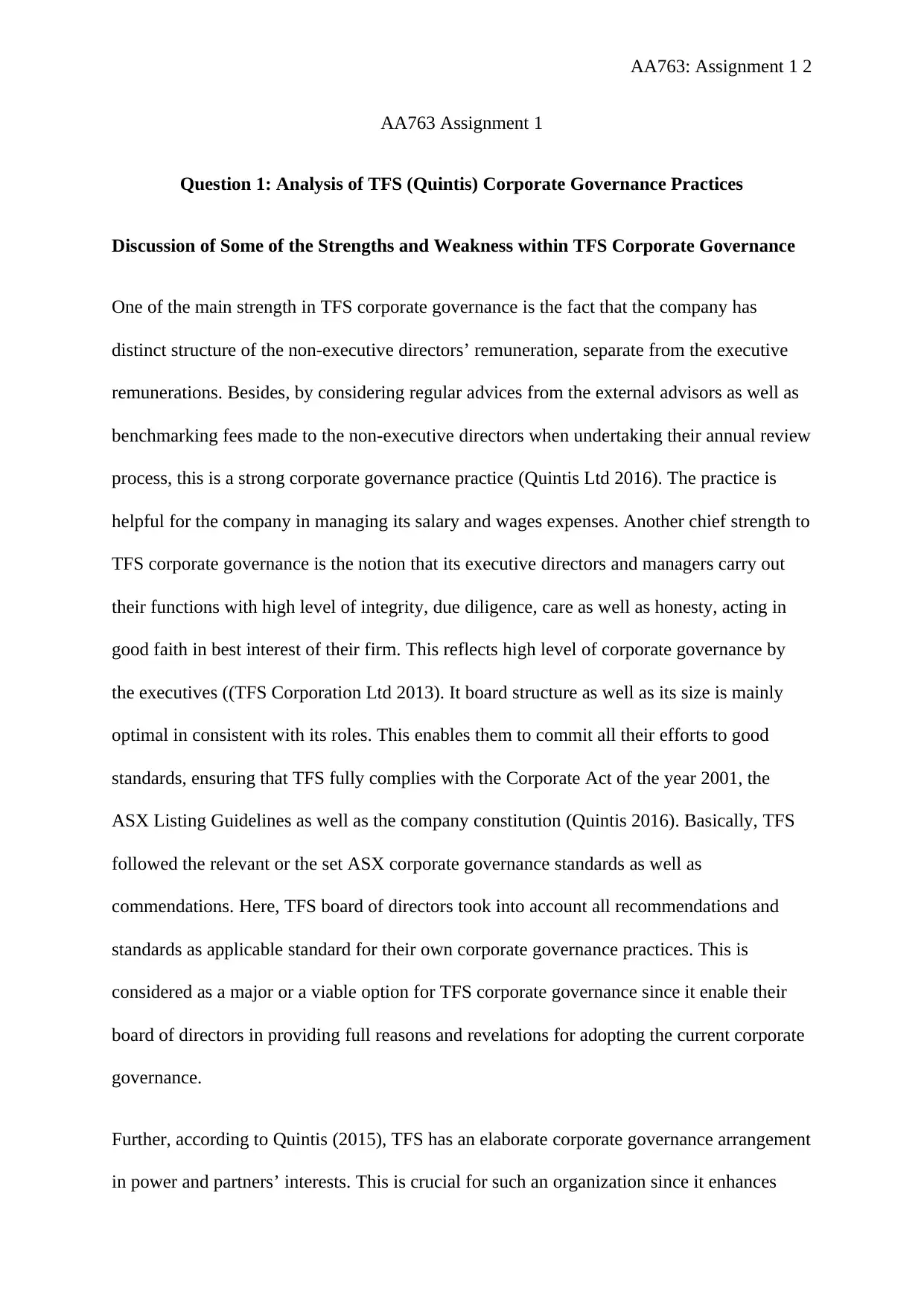
AA763: Assignment 1 2
AA763 Assignment 1
Question 1: Analysis of TFS (Quintis) Corporate Governance Practices
Discussion of Some of the Strengths and Weakness within TFS Corporate Governance
One of the main strength in TFS corporate governance is the fact that the company has
distinct structure of the non-executive directors’ remuneration, separate from the executive
remunerations. Besides, by considering regular advices from the external advisors as well as
benchmarking fees made to the non-executive directors when undertaking their annual review
process, this is a strong corporate governance practice (Quintis Ltd 2016). The practice is
helpful for the company in managing its salary and wages expenses. Another chief strength to
TFS corporate governance is the notion that its executive directors and managers carry out
their functions with high level of integrity, due diligence, care as well as honesty, acting in
good faith in best interest of their firm. This reflects high level of corporate governance by
the executives ((TFS Corporation Ltd 2013). It board structure as well as its size is mainly
optimal in consistent with its roles. This enables them to commit all their efforts to good
standards, ensuring that TFS fully complies with the Corporate Act of the year 2001, the
ASX Listing Guidelines as well as the company constitution (Quintis 2016). Basically, TFS
followed the relevant or the set ASX corporate governance standards as well as
commendations. Here, TFS board of directors took into account all recommendations and
standards as applicable standard for their own corporate governance practices. This is
considered as a major or a viable option for TFS corporate governance since it enable their
board of directors in providing full reasons and revelations for adopting the current corporate
governance.
Further, according to Quintis (2015), TFS has an elaborate corporate governance arrangement
in power and partners’ interests. This is crucial for such an organization since it enhances
AA763 Assignment 1
Question 1: Analysis of TFS (Quintis) Corporate Governance Practices
Discussion of Some of the Strengths and Weakness within TFS Corporate Governance
One of the main strength in TFS corporate governance is the fact that the company has
distinct structure of the non-executive directors’ remuneration, separate from the executive
remunerations. Besides, by considering regular advices from the external advisors as well as
benchmarking fees made to the non-executive directors when undertaking their annual review
process, this is a strong corporate governance practice (Quintis Ltd 2016). The practice is
helpful for the company in managing its salary and wages expenses. Another chief strength to
TFS corporate governance is the notion that its executive directors and managers carry out
their functions with high level of integrity, due diligence, care as well as honesty, acting in
good faith in best interest of their firm. This reflects high level of corporate governance by
the executives ((TFS Corporation Ltd 2013). It board structure as well as its size is mainly
optimal in consistent with its roles. This enables them to commit all their efforts to good
standards, ensuring that TFS fully complies with the Corporate Act of the year 2001, the
ASX Listing Guidelines as well as the company constitution (Quintis 2016). Basically, TFS
followed the relevant or the set ASX corporate governance standards as well as
commendations. Here, TFS board of directors took into account all recommendations and
standards as applicable standard for their own corporate governance practices. This is
considered as a major or a viable option for TFS corporate governance since it enable their
board of directors in providing full reasons and revelations for adopting the current corporate
governance.
Further, according to Quintis (2015), TFS has an elaborate corporate governance arrangement
in power and partners’ interests. This is crucial for such an organization since it enhances
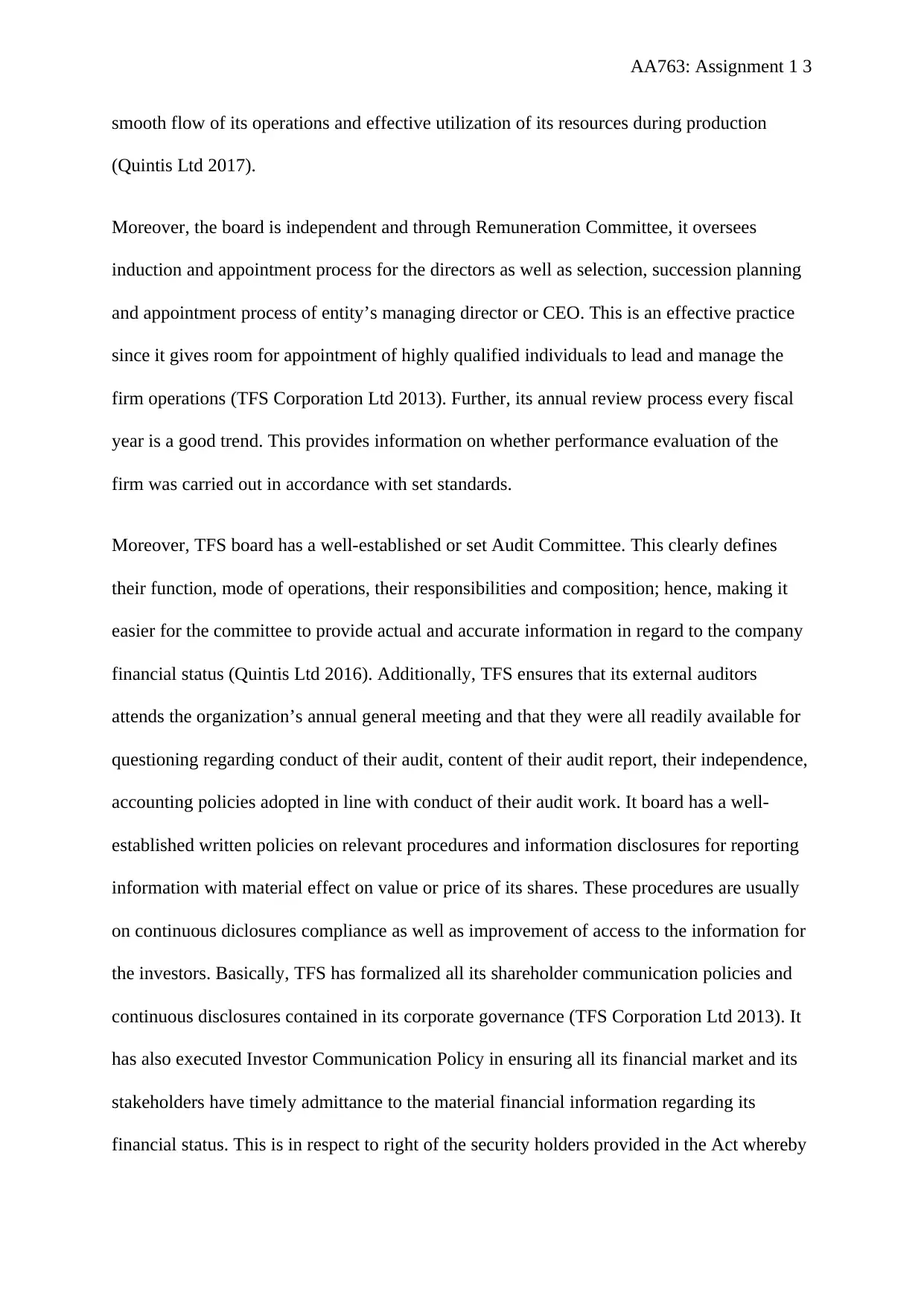
AA763: Assignment 1 3
smooth flow of its operations and effective utilization of its resources during production
(Quintis Ltd 2017).
Moreover, the board is independent and through Remuneration Committee, it oversees
induction and appointment process for the directors as well as selection, succession planning
and appointment process of entity’s managing director or CEO. This is an effective practice
since it gives room for appointment of highly qualified individuals to lead and manage the
firm operations (TFS Corporation Ltd 2013). Further, its annual review process every fiscal
year is a good trend. This provides information on whether performance evaluation of the
firm was carried out in accordance with set standards.
Moreover, TFS board has a well-established or set Audit Committee. This clearly defines
their function, mode of operations, their responsibilities and composition; hence, making it
easier for the committee to provide actual and accurate information in regard to the company
financial status (Quintis Ltd 2016). Additionally, TFS ensures that its external auditors
attends the organization’s annual general meeting and that they were all readily available for
questioning regarding conduct of their audit, content of their audit report, their independence,
accounting policies adopted in line with conduct of their audit work. It board has a well-
established written policies on relevant procedures and information disclosures for reporting
information with material effect on value or price of its shares. These procedures are usually
on continuous diclosures compliance as well as improvement of access to the information for
the investors. Basically, TFS has formalized all its shareholder communication policies and
continuous disclosures contained in its corporate governance (TFS Corporation Ltd 2013). It
has also executed Investor Communication Policy in ensuring all its financial market and its
stakeholders have timely admittance to the material financial information regarding its
financial status. This is in respect to right of the security holders provided in the Act whereby
smooth flow of its operations and effective utilization of its resources during production
(Quintis Ltd 2017).
Moreover, the board is independent and through Remuneration Committee, it oversees
induction and appointment process for the directors as well as selection, succession planning
and appointment process of entity’s managing director or CEO. This is an effective practice
since it gives room for appointment of highly qualified individuals to lead and manage the
firm operations (TFS Corporation Ltd 2013). Further, its annual review process every fiscal
year is a good trend. This provides information on whether performance evaluation of the
firm was carried out in accordance with set standards.
Moreover, TFS board has a well-established or set Audit Committee. This clearly defines
their function, mode of operations, their responsibilities and composition; hence, making it
easier for the committee to provide actual and accurate information in regard to the company
financial status (Quintis Ltd 2016). Additionally, TFS ensures that its external auditors
attends the organization’s annual general meeting and that they were all readily available for
questioning regarding conduct of their audit, content of their audit report, their independence,
accounting policies adopted in line with conduct of their audit work. It board has a well-
established written policies on relevant procedures and information disclosures for reporting
information with material effect on value or price of its shares. These procedures are usually
on continuous diclosures compliance as well as improvement of access to the information for
the investors. Basically, TFS has formalized all its shareholder communication policies and
continuous disclosures contained in its corporate governance (TFS Corporation Ltd 2013). It
has also executed Investor Communication Policy in ensuring all its financial market and its
stakeholders have timely admittance to the material financial information regarding its
financial status. This is in respect to right of the security holders provided in the Act whereby
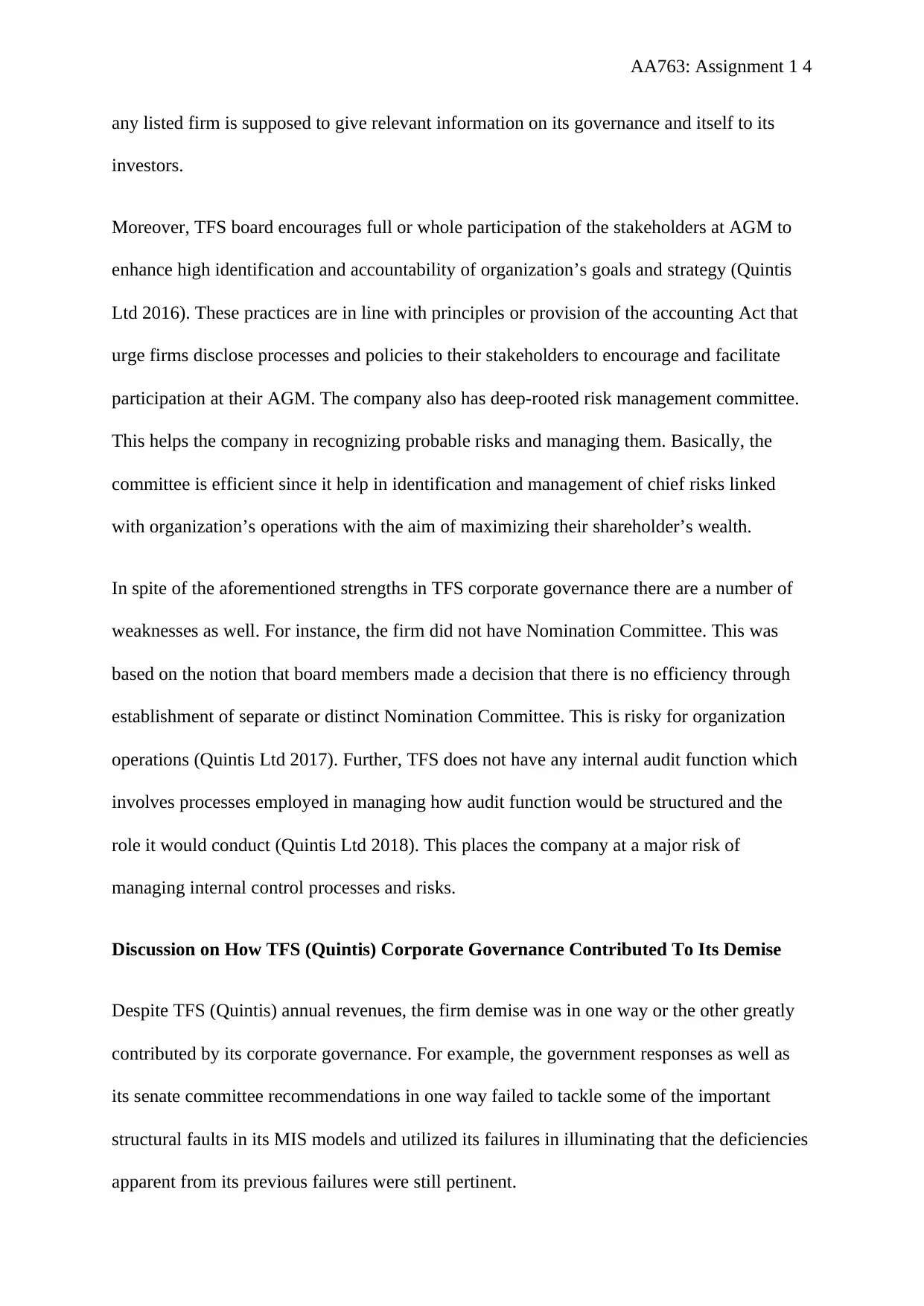
AA763: Assignment 1 4
any listed firm is supposed to give relevant information on its governance and itself to its
investors.
Moreover, TFS board encourages full or whole participation of the stakeholders at AGM to
enhance high identification and accountability of organization’s goals and strategy (Quintis
Ltd 2016). These practices are in line with principles or provision of the accounting Act that
urge firms disclose processes and policies to their stakeholders to encourage and facilitate
participation at their AGM. The company also has deep-rooted risk management committee.
This helps the company in recognizing probable risks and managing them. Basically, the
committee is efficient since it help in identification and management of chief risks linked
with organization’s operations with the aim of maximizing their shareholder’s wealth.
In spite of the aforementioned strengths in TFS corporate governance there are a number of
weaknesses as well. For instance, the firm did not have Nomination Committee. This was
based on the notion that board members made a decision that there is no efficiency through
establishment of separate or distinct Nomination Committee. This is risky for organization
operations (Quintis Ltd 2017). Further, TFS does not have any internal audit function which
involves processes employed in managing how audit function would be structured and the
role it would conduct (Quintis Ltd 2018). This places the company at a major risk of
managing internal control processes and risks.
Discussion on How TFS (Quintis) Corporate Governance Contributed To Its Demise
Despite TFS (Quintis) annual revenues, the firm demise was in one way or the other greatly
contributed by its corporate governance. For example, the government responses as well as
its senate committee recommendations in one way failed to tackle some of the important
structural faults in its MIS models and utilized its failures in illuminating that the deficiencies
apparent from its previous failures were still pertinent.
any listed firm is supposed to give relevant information on its governance and itself to its
investors.
Moreover, TFS board encourages full or whole participation of the stakeholders at AGM to
enhance high identification and accountability of organization’s goals and strategy (Quintis
Ltd 2016). These practices are in line with principles or provision of the accounting Act that
urge firms disclose processes and policies to their stakeholders to encourage and facilitate
participation at their AGM. The company also has deep-rooted risk management committee.
This helps the company in recognizing probable risks and managing them. Basically, the
committee is efficient since it help in identification and management of chief risks linked
with organization’s operations with the aim of maximizing their shareholder’s wealth.
In spite of the aforementioned strengths in TFS corporate governance there are a number of
weaknesses as well. For instance, the firm did not have Nomination Committee. This was
based on the notion that board members made a decision that there is no efficiency through
establishment of separate or distinct Nomination Committee. This is risky for organization
operations (Quintis Ltd 2017). Further, TFS does not have any internal audit function which
involves processes employed in managing how audit function would be structured and the
role it would conduct (Quintis Ltd 2018). This places the company at a major risk of
managing internal control processes and risks.
Discussion on How TFS (Quintis) Corporate Governance Contributed To Its Demise
Despite TFS (Quintis) annual revenues, the firm demise was in one way or the other greatly
contributed by its corporate governance. For example, the government responses as well as
its senate committee recommendations in one way failed to tackle some of the important
structural faults in its MIS models and utilized its failures in illuminating that the deficiencies
apparent from its previous failures were still pertinent.
Secure Best Marks with AI Grader
Need help grading? Try our AI Grader for instant feedback on your assignments.
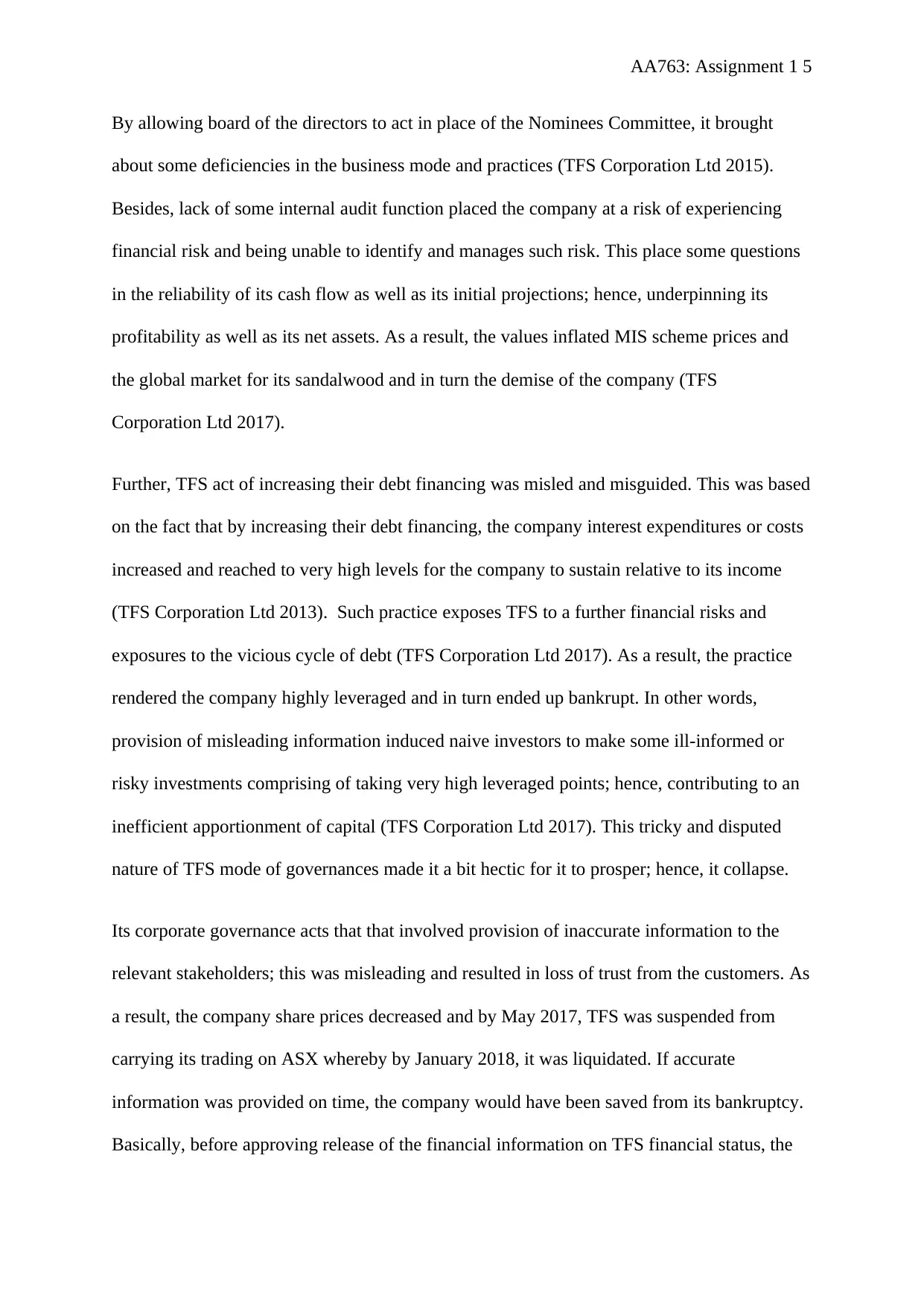
AA763: Assignment 1 5
By allowing board of the directors to act in place of the Nominees Committee, it brought
about some deficiencies in the business mode and practices (TFS Corporation Ltd 2015).
Besides, lack of some internal audit function placed the company at a risk of experiencing
financial risk and being unable to identify and manages such risk. This place some questions
in the reliability of its cash flow as well as its initial projections; hence, underpinning its
profitability as well as its net assets. As a result, the values inflated MIS scheme prices and
the global market for its sandalwood and in turn the demise of the company (TFS
Corporation Ltd 2017).
Further, TFS act of increasing their debt financing was misled and misguided. This was based
on the fact that by increasing their debt financing, the company interest expenditures or costs
increased and reached to very high levels for the company to sustain relative to its income
(TFS Corporation Ltd 2013). Such practice exposes TFS to a further financial risks and
exposures to the vicious cycle of debt (TFS Corporation Ltd 2017). As a result, the practice
rendered the company highly leveraged and in turn ended up bankrupt. In other words,
provision of misleading information induced naive investors to make some ill-informed or
risky investments comprising of taking very high leveraged points; hence, contributing to an
inefficient apportionment of capital (TFS Corporation Ltd 2017). This tricky and disputed
nature of TFS mode of governances made it a bit hectic for it to prosper; hence, it collapse.
Its corporate governance acts that that involved provision of inaccurate information to the
relevant stakeholders; this was misleading and resulted in loss of trust from the customers. As
a result, the company share prices decreased and by May 2017, TFS was suspended from
carrying its trading on ASX whereby by January 2018, it was liquidated. If accurate
information was provided on time, the company would have been saved from its bankruptcy.
Basically, before approving release of the financial information on TFS financial status, the
By allowing board of the directors to act in place of the Nominees Committee, it brought
about some deficiencies in the business mode and practices (TFS Corporation Ltd 2015).
Besides, lack of some internal audit function placed the company at a risk of experiencing
financial risk and being unable to identify and manages such risk. This place some questions
in the reliability of its cash flow as well as its initial projections; hence, underpinning its
profitability as well as its net assets. As a result, the values inflated MIS scheme prices and
the global market for its sandalwood and in turn the demise of the company (TFS
Corporation Ltd 2017).
Further, TFS act of increasing their debt financing was misled and misguided. This was based
on the fact that by increasing their debt financing, the company interest expenditures or costs
increased and reached to very high levels for the company to sustain relative to its income
(TFS Corporation Ltd 2013). Such practice exposes TFS to a further financial risks and
exposures to the vicious cycle of debt (TFS Corporation Ltd 2017). As a result, the practice
rendered the company highly leveraged and in turn ended up bankrupt. In other words,
provision of misleading information induced naive investors to make some ill-informed or
risky investments comprising of taking very high leveraged points; hence, contributing to an
inefficient apportionment of capital (TFS Corporation Ltd 2017). This tricky and disputed
nature of TFS mode of governances made it a bit hectic for it to prosper; hence, it collapse.
Its corporate governance acts that that involved provision of inaccurate information to the
relevant stakeholders; this was misleading and resulted in loss of trust from the customers. As
a result, the company share prices decreased and by May 2017, TFS was suspended from
carrying its trading on ASX whereby by January 2018, it was liquidated. If accurate
information was provided on time, the company would have been saved from its bankruptcy.
Basically, before approving release of the financial information on TFS financial status, the
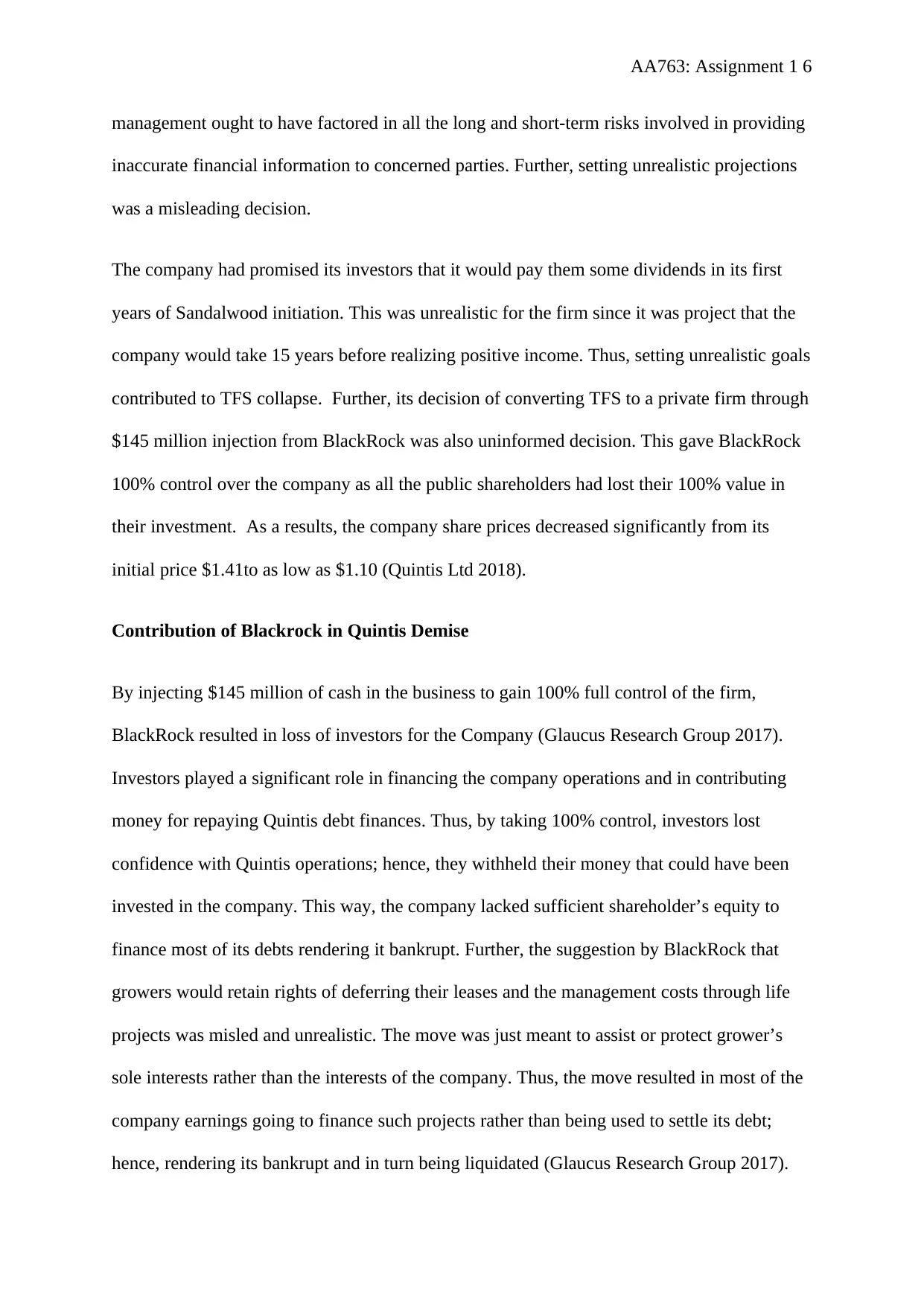
AA763: Assignment 1 6
management ought to have factored in all the long and short-term risks involved in providing
inaccurate financial information to concerned parties. Further, setting unrealistic projections
was a misleading decision.
The company had promised its investors that it would pay them some dividends in its first
years of Sandalwood initiation. This was unrealistic for the firm since it was project that the
company would take 15 years before realizing positive income. Thus, setting unrealistic goals
contributed to TFS collapse. Further, its decision of converting TFS to a private firm through
$145 million injection from BlackRock was also uninformed decision. This gave BlackRock
100% control over the company as all the public shareholders had lost their 100% value in
their investment. As a results, the company share prices decreased significantly from its
initial price $1.41to as low as $1.10 (Quintis Ltd 2018).
Contribution of Blackrock in Quintis Demise
By injecting $145 million of cash in the business to gain 100% full control of the firm,
BlackRock resulted in loss of investors for the Company (Glaucus Research Group 2017).
Investors played a significant role in financing the company operations and in contributing
money for repaying Quintis debt finances. Thus, by taking 100% control, investors lost
confidence with Quintis operations; hence, they withheld their money that could have been
invested in the company. This way, the company lacked sufficient shareholder’s equity to
finance most of its debts rendering it bankrupt. Further, the suggestion by BlackRock that
growers would retain rights of deferring their leases and the management costs through life
projects was misled and unrealistic. The move was just meant to assist or protect grower’s
sole interests rather than the interests of the company. Thus, the move resulted in most of the
company earnings going to finance such projects rather than being used to settle its debt;
hence, rendering its bankrupt and in turn being liquidated (Glaucus Research Group 2017).
management ought to have factored in all the long and short-term risks involved in providing
inaccurate financial information to concerned parties. Further, setting unrealistic projections
was a misleading decision.
The company had promised its investors that it would pay them some dividends in its first
years of Sandalwood initiation. This was unrealistic for the firm since it was project that the
company would take 15 years before realizing positive income. Thus, setting unrealistic goals
contributed to TFS collapse. Further, its decision of converting TFS to a private firm through
$145 million injection from BlackRock was also uninformed decision. This gave BlackRock
100% control over the company as all the public shareholders had lost their 100% value in
their investment. As a results, the company share prices decreased significantly from its
initial price $1.41to as low as $1.10 (Quintis Ltd 2018).
Contribution of Blackrock in Quintis Demise
By injecting $145 million of cash in the business to gain 100% full control of the firm,
BlackRock resulted in loss of investors for the Company (Glaucus Research Group 2017).
Investors played a significant role in financing the company operations and in contributing
money for repaying Quintis debt finances. Thus, by taking 100% control, investors lost
confidence with Quintis operations; hence, they withheld their money that could have been
invested in the company. This way, the company lacked sufficient shareholder’s equity to
finance most of its debts rendering it bankrupt. Further, the suggestion by BlackRock that
growers would retain rights of deferring their leases and the management costs through life
projects was misled and unrealistic. The move was just meant to assist or protect grower’s
sole interests rather than the interests of the company. Thus, the move resulted in most of the
company earnings going to finance such projects rather than being used to settle its debt;
hence, rendering its bankrupt and in turn being liquidated (Glaucus Research Group 2017).
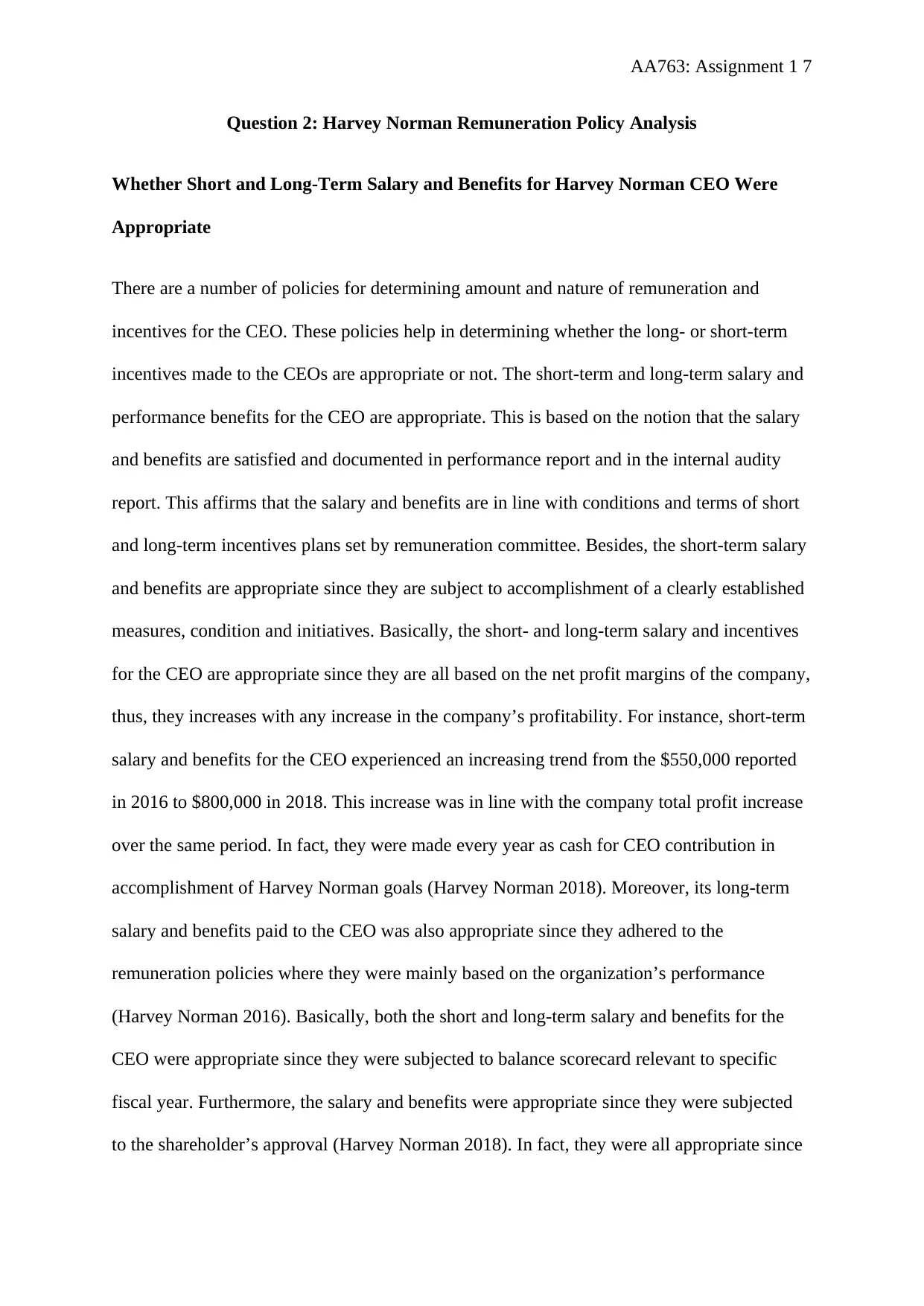
AA763: Assignment 1 7
Question 2: Harvey Norman Remuneration Policy Analysis
Whether Short and Long-Term Salary and Benefits for Harvey Norman CEO Were
Appropriate
There are a number of policies for determining amount and nature of remuneration and
incentives for the CEO. These policies help in determining whether the long- or short-term
incentives made to the CEOs are appropriate or not. The short-term and long-term salary and
performance benefits for the CEO are appropriate. This is based on the notion that the salary
and benefits are satisfied and documented in performance report and in the internal audity
report. This affirms that the salary and benefits are in line with conditions and terms of short
and long-term incentives plans set by remuneration committee. Besides, the short-term salary
and benefits are appropriate since they are subject to accomplishment of a clearly established
measures, condition and initiatives. Basically, the short- and long-term salary and incentives
for the CEO are appropriate since they are all based on the net profit margins of the company,
thus, they increases with any increase in the company’s profitability. For instance, short-term
salary and benefits for the CEO experienced an increasing trend from the $550,000 reported
in 2016 to $800,000 in 2018. This increase was in line with the company total profit increase
over the same period. In fact, they were made every year as cash for CEO contribution in
accomplishment of Harvey Norman goals (Harvey Norman 2018). Moreover, its long-term
salary and benefits paid to the CEO was also appropriate since they adhered to the
remuneration policies where they were mainly based on the organization’s performance
(Harvey Norman 2016). Basically, both the short and long-term salary and benefits for the
CEO were appropriate since they were subjected to balance scorecard relevant to specific
fiscal year. Furthermore, the salary and benefits were appropriate since they were subjected
to the shareholder’s approval (Harvey Norman 2018). In fact, they were all appropriate since
Question 2: Harvey Norman Remuneration Policy Analysis
Whether Short and Long-Term Salary and Benefits for Harvey Norman CEO Were
Appropriate
There are a number of policies for determining amount and nature of remuneration and
incentives for the CEO. These policies help in determining whether the long- or short-term
incentives made to the CEOs are appropriate or not. The short-term and long-term salary and
performance benefits for the CEO are appropriate. This is based on the notion that the salary
and benefits are satisfied and documented in performance report and in the internal audity
report. This affirms that the salary and benefits are in line with conditions and terms of short
and long-term incentives plans set by remuneration committee. Besides, the short-term salary
and benefits are appropriate since they are subject to accomplishment of a clearly established
measures, condition and initiatives. Basically, the short- and long-term salary and incentives
for the CEO are appropriate since they are all based on the net profit margins of the company,
thus, they increases with any increase in the company’s profitability. For instance, short-term
salary and benefits for the CEO experienced an increasing trend from the $550,000 reported
in 2016 to $800,000 in 2018. This increase was in line with the company total profit increase
over the same period. In fact, they were made every year as cash for CEO contribution in
accomplishment of Harvey Norman goals (Harvey Norman 2018). Moreover, its long-term
salary and benefits paid to the CEO was also appropriate since they adhered to the
remuneration policies where they were mainly based on the organization’s performance
(Harvey Norman 2016). Basically, both the short and long-term salary and benefits for the
CEO were appropriate since they were subjected to balance scorecard relevant to specific
fiscal year. Furthermore, the salary and benefits were appropriate since they were subjected
to the shareholder’s approval (Harvey Norman 2018). In fact, they were all appropriate since
Paraphrase This Document
Need a fresh take? Get an instant paraphrase of this document with our AI Paraphraser
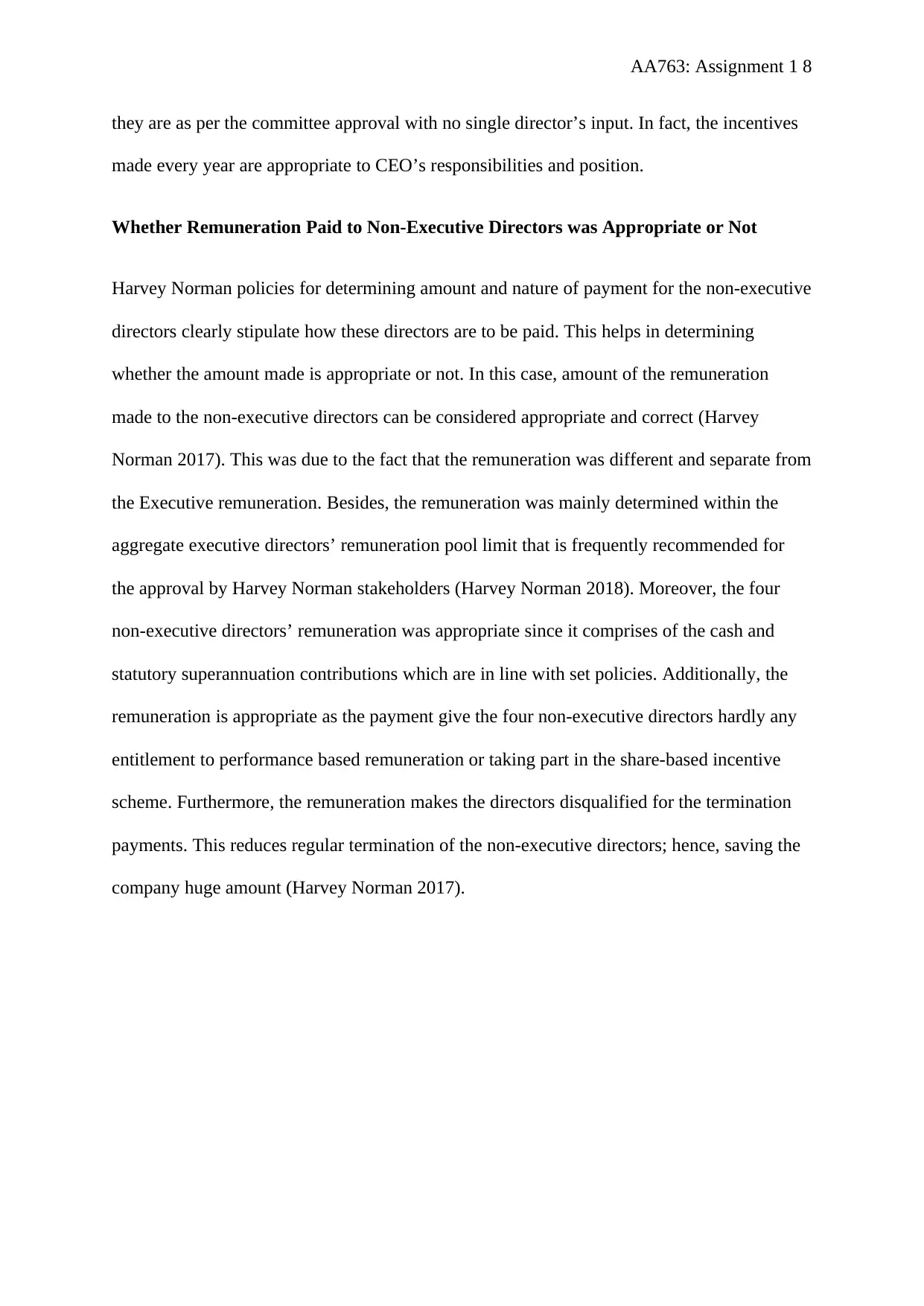
AA763: Assignment 1 8
they are as per the committee approval with no single director’s input. In fact, the incentives
made every year are appropriate to CEO’s responsibilities and position.
Whether Remuneration Paid to Non-Executive Directors was Appropriate or Not
Harvey Norman policies for determining amount and nature of payment for the non-executive
directors clearly stipulate how these directors are to be paid. This helps in determining
whether the amount made is appropriate or not. In this case, amount of the remuneration
made to the non-executive directors can be considered appropriate and correct (Harvey
Norman 2017). This was due to the fact that the remuneration was different and separate from
the Executive remuneration. Besides, the remuneration was mainly determined within the
aggregate executive directors’ remuneration pool limit that is frequently recommended for
the approval by Harvey Norman stakeholders (Harvey Norman 2018). Moreover, the four
non-executive directors’ remuneration was appropriate since it comprises of the cash and
statutory superannuation contributions which are in line with set policies. Additionally, the
remuneration is appropriate as the payment give the four non-executive directors hardly any
entitlement to performance based remuneration or taking part in the share-based incentive
scheme. Furthermore, the remuneration makes the directors disqualified for the termination
payments. This reduces regular termination of the non-executive directors; hence, saving the
company huge amount (Harvey Norman 2017).
they are as per the committee approval with no single director’s input. In fact, the incentives
made every year are appropriate to CEO’s responsibilities and position.
Whether Remuneration Paid to Non-Executive Directors was Appropriate or Not
Harvey Norman policies for determining amount and nature of payment for the non-executive
directors clearly stipulate how these directors are to be paid. This helps in determining
whether the amount made is appropriate or not. In this case, amount of the remuneration
made to the non-executive directors can be considered appropriate and correct (Harvey
Norman 2017). This was due to the fact that the remuneration was different and separate from
the Executive remuneration. Besides, the remuneration was mainly determined within the
aggregate executive directors’ remuneration pool limit that is frequently recommended for
the approval by Harvey Norman stakeholders (Harvey Norman 2018). Moreover, the four
non-executive directors’ remuneration was appropriate since it comprises of the cash and
statutory superannuation contributions which are in line with set policies. Additionally, the
remuneration is appropriate as the payment give the four non-executive directors hardly any
entitlement to performance based remuneration or taking part in the share-based incentive
scheme. Furthermore, the remuneration makes the directors disqualified for the termination
payments. This reduces regular termination of the non-executive directors; hence, saving the
company huge amount (Harvey Norman 2017).
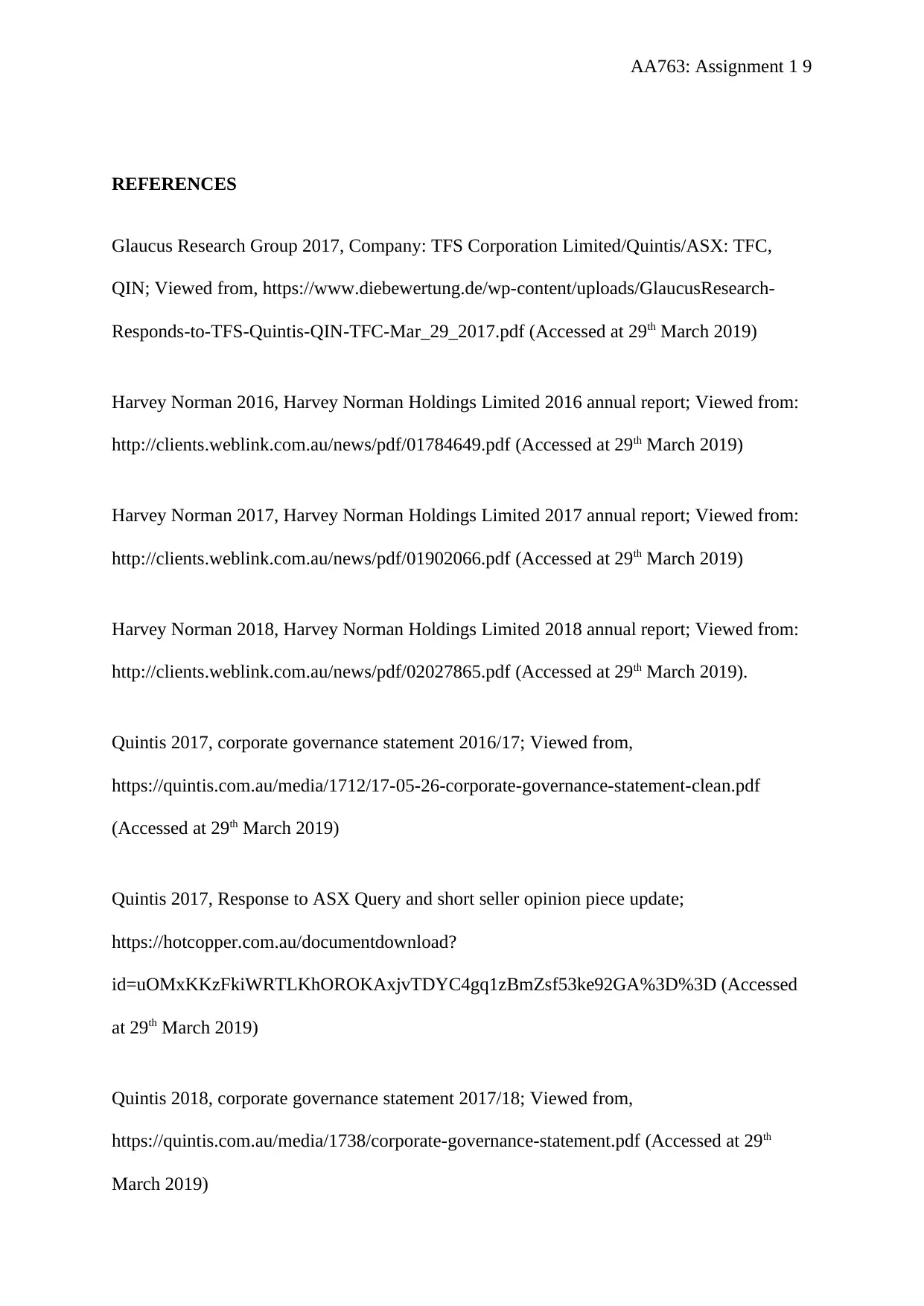
AA763: Assignment 1 9
REFERENCES
Glaucus Research Group 2017, Company: TFS Corporation Limited/Quintis/ASX: TFC,
QIN; Viewed from, https://www.diebewertung.de/wp-content/uploads/GlaucusResearch-
Responds-to-TFS-Quintis-QIN-TFC-Mar_29_2017.pdf (Accessed at 29th March 2019)
Harvey Norman 2016, Harvey Norman Holdings Limited 2016 annual report; Viewed from:
http://clients.weblink.com.au/news/pdf/01784649.pdf (Accessed at 29th March 2019)
Harvey Norman 2017, Harvey Norman Holdings Limited 2017 annual report; Viewed from:
http://clients.weblink.com.au/news/pdf/01902066.pdf (Accessed at 29th March 2019)
Harvey Norman 2018, Harvey Norman Holdings Limited 2018 annual report; Viewed from:
http://clients.weblink.com.au/news/pdf/02027865.pdf (Accessed at 29th March 2019).
Quintis 2017, corporate governance statement 2016/17; Viewed from,
https://quintis.com.au/media/1712/17-05-26-corporate-governance-statement-clean.pdf
(Accessed at 29th March 2019)
Quintis 2017, Response to ASX Query and short seller opinion piece update;
https://hotcopper.com.au/documentdownload?
id=uOMxKKzFkiWRTLKhOROKAxjvTDYC4gq1zBmZsf53ke92GA%3D%3D (Accessed
at 29th March 2019)
Quintis 2018, corporate governance statement 2017/18; Viewed from,
https://quintis.com.au/media/1738/corporate-governance-statement.pdf (Accessed at 29th
March 2019)
REFERENCES
Glaucus Research Group 2017, Company: TFS Corporation Limited/Quintis/ASX: TFC,
QIN; Viewed from, https://www.diebewertung.de/wp-content/uploads/GlaucusResearch-
Responds-to-TFS-Quintis-QIN-TFC-Mar_29_2017.pdf (Accessed at 29th March 2019)
Harvey Norman 2016, Harvey Norman Holdings Limited 2016 annual report; Viewed from:
http://clients.weblink.com.au/news/pdf/01784649.pdf (Accessed at 29th March 2019)
Harvey Norman 2017, Harvey Norman Holdings Limited 2017 annual report; Viewed from:
http://clients.weblink.com.au/news/pdf/01902066.pdf (Accessed at 29th March 2019)
Harvey Norman 2018, Harvey Norman Holdings Limited 2018 annual report; Viewed from:
http://clients.weblink.com.au/news/pdf/02027865.pdf (Accessed at 29th March 2019).
Quintis 2017, corporate governance statement 2016/17; Viewed from,
https://quintis.com.au/media/1712/17-05-26-corporate-governance-statement-clean.pdf
(Accessed at 29th March 2019)
Quintis 2017, Response to ASX Query and short seller opinion piece update;
https://hotcopper.com.au/documentdownload?
id=uOMxKKzFkiWRTLKhOROKAxjvTDYC4gq1zBmZsf53ke92GA%3D%3D (Accessed
at 29th March 2019)
Quintis 2018, corporate governance statement 2017/18; Viewed from,
https://quintis.com.au/media/1738/corporate-governance-statement.pdf (Accessed at 29th
March 2019)
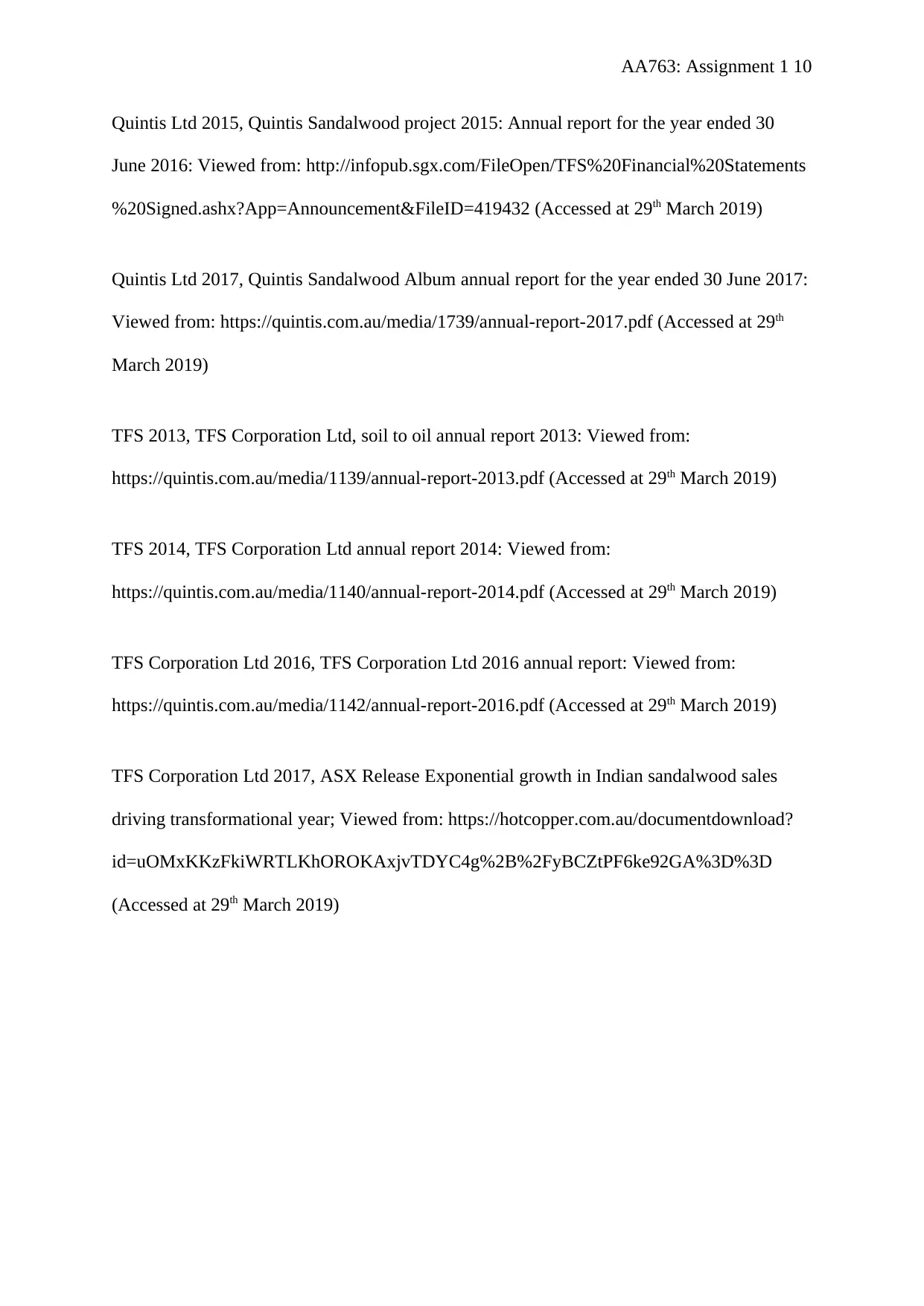
AA763: Assignment 1 10
Quintis Ltd 2015, Quintis Sandalwood project 2015: Annual report for the year ended 30
June 2016: Viewed from: http://infopub.sgx.com/FileOpen/TFS%20Financial%20Statements
%20Signed.ashx?App=Announcement&FileID=419432 (Accessed at 29th March 2019)
Quintis Ltd 2017, Quintis Sandalwood Album annual report for the year ended 30 June 2017:
Viewed from: https://quintis.com.au/media/1739/annual-report-2017.pdf (Accessed at 29th
March 2019)
TFS 2013, TFS Corporation Ltd, soil to oil annual report 2013: Viewed from:
https://quintis.com.au/media/1139/annual-report-2013.pdf (Accessed at 29th March 2019)
TFS 2014, TFS Corporation Ltd annual report 2014: Viewed from:
https://quintis.com.au/media/1140/annual-report-2014.pdf (Accessed at 29th March 2019)
TFS Corporation Ltd 2016, TFS Corporation Ltd 2016 annual report: Viewed from:
https://quintis.com.au/media/1142/annual-report-2016.pdf (Accessed at 29th March 2019)
TFS Corporation Ltd 2017, ASX Release Exponential growth in Indian sandalwood sales
driving transformational year; Viewed from: https://hotcopper.com.au/documentdownload?
id=uOMxKKzFkiWRTLKhOROKAxjvTDYC4g%2B%2FyBCZtPF6ke92GA%3D%3D
(Accessed at 29th March 2019)
Quintis Ltd 2015, Quintis Sandalwood project 2015: Annual report for the year ended 30
June 2016: Viewed from: http://infopub.sgx.com/FileOpen/TFS%20Financial%20Statements
%20Signed.ashx?App=Announcement&FileID=419432 (Accessed at 29th March 2019)
Quintis Ltd 2017, Quintis Sandalwood Album annual report for the year ended 30 June 2017:
Viewed from: https://quintis.com.au/media/1739/annual-report-2017.pdf (Accessed at 29th
March 2019)
TFS 2013, TFS Corporation Ltd, soil to oil annual report 2013: Viewed from:
https://quintis.com.au/media/1139/annual-report-2013.pdf (Accessed at 29th March 2019)
TFS 2014, TFS Corporation Ltd annual report 2014: Viewed from:
https://quintis.com.au/media/1140/annual-report-2014.pdf (Accessed at 29th March 2019)
TFS Corporation Ltd 2016, TFS Corporation Ltd 2016 annual report: Viewed from:
https://quintis.com.au/media/1142/annual-report-2016.pdf (Accessed at 29th March 2019)
TFS Corporation Ltd 2017, ASX Release Exponential growth in Indian sandalwood sales
driving transformational year; Viewed from: https://hotcopper.com.au/documentdownload?
id=uOMxKKzFkiWRTLKhOROKAxjvTDYC4g%2B%2FyBCZtPF6ke92GA%3D%3D
(Accessed at 29th March 2019)
1 out of 10
Related Documents
Your All-in-One AI-Powered Toolkit for Academic Success.
+13062052269
info@desklib.com
Available 24*7 on WhatsApp / Email
![[object Object]](/_next/static/media/star-bottom.7253800d.svg)
Unlock your academic potential
© 2024 | Zucol Services PVT LTD | All rights reserved.





